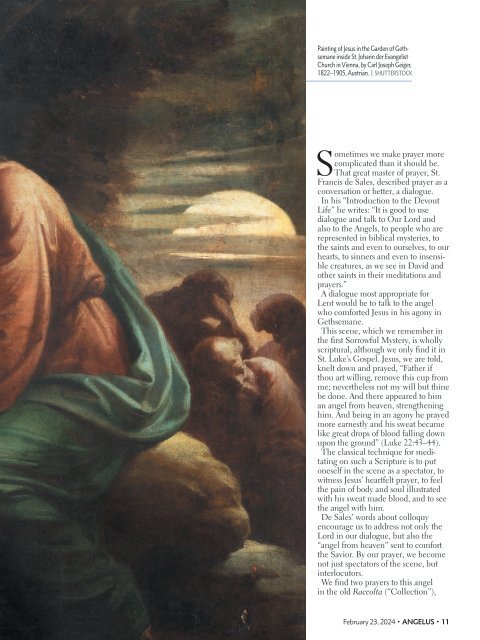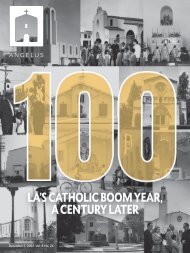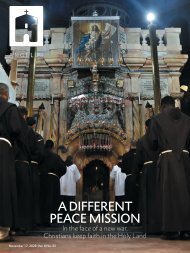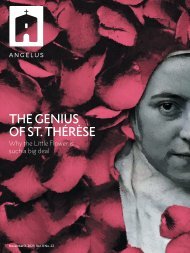Angelus News | February 23, 2024 | Vol. 9 No. 4
On the cover: A painting depicting Jesus in the Garden of Gethsemane by 19th-century artist Carl Heinrich Bloch. For Christians, Lent can be compared to the time Jesus spent praying in the desert. But we may also find ourselves this time of year in the agony of the garden, going through our own Gethsemane of personal suffering. On Page 10, Msgr. Richard Antall reflects on two traditional prayers to the same angel that comforted Christ on the Mount of Olives.
On the cover: A painting depicting Jesus in the Garden of Gethsemane by 19th-century artist Carl Heinrich Bloch. For Christians, Lent can be compared to the time Jesus spent praying in the desert. But we may also find ourselves this time of year in the agony of the garden, going through our own Gethsemane of personal suffering. On Page 10, Msgr. Richard Antall reflects on two traditional prayers to the same angel that comforted Christ on the Mount of Olives.
Create successful ePaper yourself
Turn your PDF publications into a flip-book with our unique Google optimized e-Paper software.
Painting of Jesus in the Garden of Gethsemane<br />
inside St. Johann der Evangelist<br />
Church in Vienna, by Carl Joseph Geiger,<br />
1822–1905, Austrian. | SHUTTERSTOCK<br />
Sometimes we make prayer more<br />
complicated than it should be.<br />
That great master of prayer, St.<br />
Francis de Sales, described prayer as a<br />
conversation or better, a dialogue.<br />
In his “Introduction to the Devout<br />
Life” he writes: “It is good to use<br />
dialogue and talk to Our Lord and<br />
also to the Angels, to people who are<br />
represented in biblical mysteries, to<br />
the saints and even to ourselves, to our<br />
hearts, to sinners and even to insensible<br />
creatures, as we see in David and<br />
other saints in their meditations and<br />
prayers.”<br />
A dialogue most appropriate for<br />
Lent would be to talk to the angel<br />
who comforted Jesus in his agony in<br />
Gethsemane.<br />
This scene, which we remember in<br />
the first Sorrowful Mystery, is wholly<br />
scriptural, although we only find it in<br />
St. Luke’s Gospel. Jesus, we are told,<br />
knelt down and prayed, “Father if<br />
thou art willing, remove this cup from<br />
me; nevertheless not my will but thine<br />
be done. And there appeared to him<br />
an angel from heaven, strengthening<br />
him. And being in an agony he prayed<br />
more earnestly and his sweat became<br />
like great drops of blood falling down<br />
upon the ground” (Luke 22:43–44).<br />
The classical technique for meditating<br />
on such a Scripture is to put<br />
oneself in the scene as a spectator, to<br />
witness Jesus’ heartfelt prayer, to feel<br />
the pain of body and soul illustrated<br />
with his sweat made blood, and to see<br />
the angel with him.<br />
De Sales’ words about colloquy<br />
encourage us to address not only the<br />
Lord in our dialogue, but also the<br />
“angel from heaven” sent to comfort<br />
the Savior. By our prayer, we become<br />
not just spectators of the scene, but<br />
interlocutors.<br />
We find two prayers to this angel<br />
in the old Raccolta (“Collection”),<br />
<strong>February</strong> <strong>23</strong>, <strong>2024</strong> • ANGELUS • 11

















